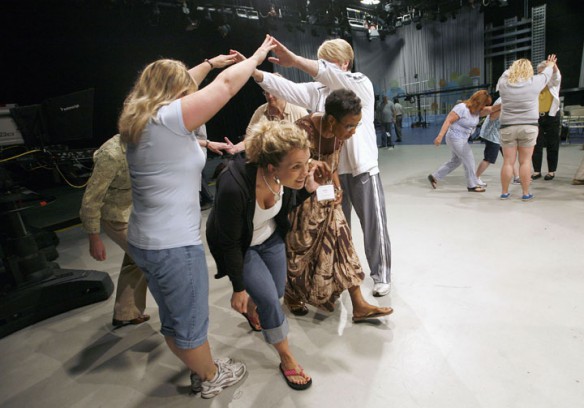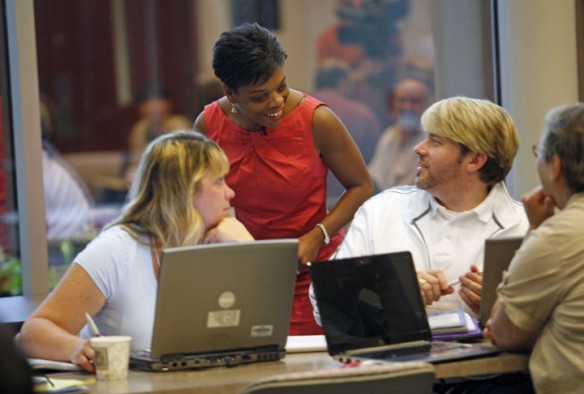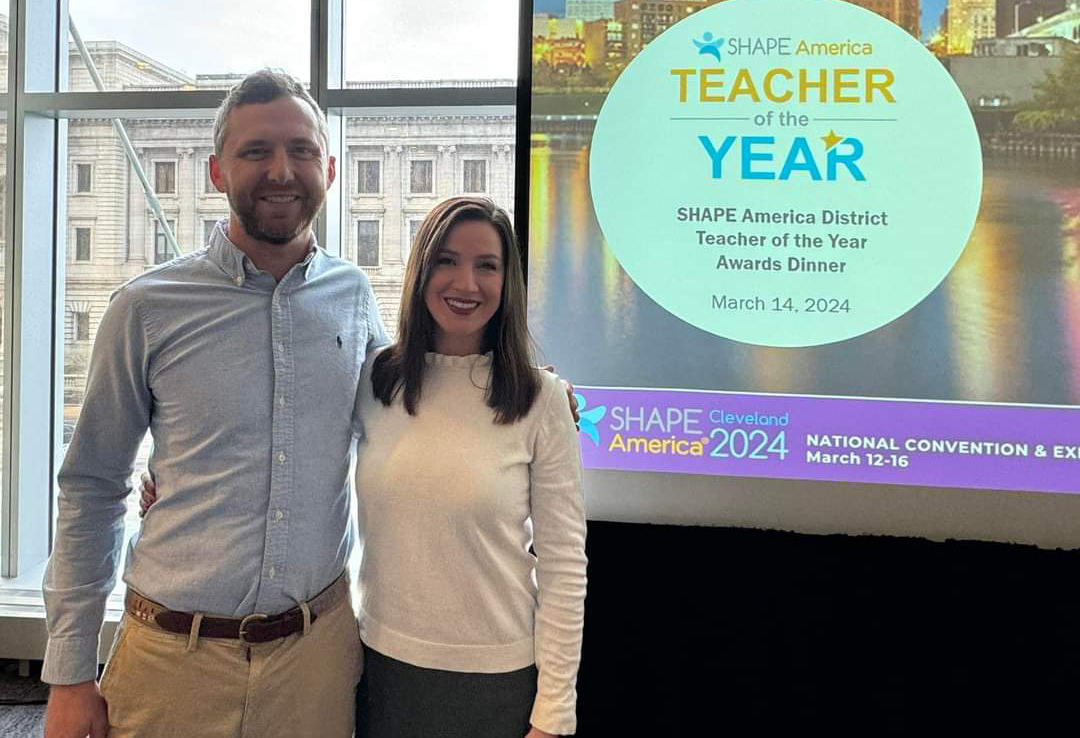
Flemingsburg Elementary School (Fleming County) teacher Lindsey Moran, left, and Garden Springs Elementary School (Fayette County) teacher Lanora Long dance the Sir Roger de Coverley during the Next Generation Academy in Lexington. Photo by Amy Wallot, June 16, 2011
By Matthew Tungate
During the last school year, 8th-grade social studies teacher Robyn Hetman did something different with her classes at F.T. Burns Middle School (Daviess County).
Hetman said she emphasized primary sources, including using pictures from Kentucky Educational Television (KET) taken in Louisville during a unit on Civil Rights. Students couldn’t get enough, she said.
She had a student tell her, “I love this class. When did I start loving this class?”
Hetman said using the photographs made all the difference, and she wanted to find additional ways to integrate visual arts and other art forms with social studies.
“I don’t see how you can teach social studies without teaching the arts,” she said. “I think that it’s critical that we embrace the arts,” she said.
Hetman and 37 other teachers spent last week at KET in Lexington learning how to do exactly that at the first Next Generation Academy: Integrating Social Studies, the Arts, and Technology. For the last 10 years, the Kentucky Department of Education (KDE) and the Kentucky Center for the Performing Arts have put on weeklong Summer Arts Academies for teachers to receive training in two art forms: music and dance, and visual arts and drama.
This year, however, only two arts academies will be devoted to music and dance, and visual arts and drama. Two Next Generation Academies have been added: one for integrating social studies and the arts, and another for integrating world languages with the arts.
Jeffrey Jamner, director of School Programs for the Kentucky Center for the Performing Arts in Louisville and coordinator of the center’s Summer Arts Academies for teachers, said more than 2,000 teachers have attended one or both of the original Arts Academies and were ready for “next-generation training.”
About 160 teachers applied for the 32 spots to attend the Next Generation Academy: Integrating Social Studies, the Arts, and Technology, Jamner said. Preference went to arts teachers who had been to both arts academies and applied as a team with a social studies teacher. In all, 38 teachers from 19 schools in 13 districts and the University of Kentucky’s P-20 Innovation Lab attended the new academy, Jamner said.
Attendees received training in four art forms (visual arts, music, dance and drama); integrating civics with each art form individually and together; standards, assessment and accountability in arts and social studies; and using video.
Jamner said it was important to show teachers how to use video to document learning and creative work, and as a means of formative and summative assessments. Each team of teachers will receive a pocket video camera, he said.
“We’ve been videotaping portions of their workshops, and we can play that back for them, and that can be used to give them feedback that they can see for themselves how they’re growing and where they can go from there,” he said.
There is a benefit to participants coming in pairs with an arts teacher and social studies teacher, Jamner said.
“The goal is that they would not only experience integrated lessons here, they would spend time at the academy developing integrated lessons that they could use during the school year,” he said. “We’re teaching process of integrated lessons.”
The teachers also took a field trip to Ashland: The Henry Clay Estate. Teachers participated in a dramatic performance with an actor portraying Henry Clay, learned music and dance from the time and studied objects in the home to see what they told about the era.
“It’s a lot of hands-on in the art forms and social studies in a way that models integration,” he said.
Both 2009’s Senate Bill 1 and 21st-century skills emphasize making connections between subjects, Jamner said.
“That is really the genesis of this academy: responding to that need,” he said.
Conflict, compromise, cooperation common in arts, social studies and integration
As social studies is overwhelmingly broad, Jamner asked KDE social studies consultant Mendy Meehan to provide a focus for the training.
“She gave us a civics lens, which involves conflict, compromise and cooperation. Through that lens, you can apply that to any point in time in history, to any place. It’s also part of the artistic process. And that very process is a 21st-century skill: learning to work in teams. It is also the process that teachers will need to collaborate in order to integrate in their schools,” Jamner said.
Teachers will need to listen to each other’s educational goals and come up with a plan that meets the needs of both subjects, he said.
“What we want to show is that when you integrate, you’re doing justice to both subjects that you’re integrating, that you really are teaching to the curriculum standards in the arts and in social studies, that you’re making meaningful and powerful connections between them,” Jamner said. “We want this to be more intentional, more planned collaboration and more meaningful integration.”
That was one of the thrusts of a presentation given by KDE arts consultant Robert Duncan, who spoke to a group of teachers about integrating visual arts and social studies.
Duncan emphasized that social studies and art teachers should collaborate. A teacher in the audience said a social studies teacher at her school was teaching a unit on the Appalachian Mountains and felt she had integrated music into the lesson by teaching an Appalachian song. Many of the teachers shook their heads – some acknowledging that is not integration, others because they could commiserate.
Duncan said that collaboration has to be meaningful and purposeful – teaching elements of both subjects.

Associate Commissioner Felicia Cumings Smith, center, talks with Hunter Hills Elementary School (Laurel County) teachers Trish Brittain and Jon Oliver during the Next Generation Academy in Lexington. Photo by Amy Wallot, June 16, 2011
“A science teacher doesn’t need to come to you (art teachers) on a Monday and say, ‘We’re learning about bugs tomorrow. Can you teach them something about bugs?’” he said.
Duncan, who spent 28 years teaching high school visual arts, had the teachers examine John Gast’s American Progress.
“Social studies has such a natural connection with the arts because of history,” he said.
Duncan discussed the elements and principals of design used in the painting. While he was trying to get teachers to focus on issues of line, texture and color, they wanted to talk more about what the painting said about westward expansion and manifest destiny.
“Why are we slowly – even painfully – looking at every detail of this piece?” he asked. “Because it draws interest in the piece.”
When social studies teachers do incorporate visual arts, Duncan said they should use a rubric for grading the work and hold students to a high standard – work should be neat and clean as well as show comprehension of content and effort.
“As a social studies teacher, you don’t accept writing you can’t read,” he said.
Students need to do more than staple pictures they’ve printed off of the Internet onto poster board to do good work, Duncan said.
“They’ve got to show you that an art project is not just a nice relief from class,” he said.
The session ended with a discussion on whether a photo taken in the Situation Room of the White House during the attack on Osama bin Laden is art.
Charles Ramey, an art teacher at Lebanon Elementary School (Marion County), asked, “What isn’t art?”
Ramey said he’s been to two other Arts Academies and “they’ve been very valuable.”
He said integrating the arts with social studies and other subjects teaches the whole learner and makes connections between subjects.
“Arts integration is vital to inspire creative thought and performance in all subjects,” Ramey said, “which is critical for the future progress of society and country.”
Hetman acknowledged later to being one of the teachers who would ask for music at the last minute.
“I think my methods will change,” she said.
The 20-year veteran said any teacher who leaves the academy without being rejuvenated should give up the profession.
“I’ve got more good ideas in a day and half here than sometimes I get in three or four days at a social studies workshop where they don’t even let us out of our seats to do anything,” she said.
Attendees field testing KET Social Studies Arts Toolkit
Attendees at the Next Generation Academy: Integrating Social Studies, the Arts, and Technology will be the first teachers in the state to use the KET Social Studies Arts Toolkit prototype.
Teresa Day, director of arts and special projects at KET, said it is similar to the KET Arts Toolkits the organization has created over the last decade.
“As we worked with that content, we became really aware of all the connections between arts and social studies, and other subject areas as well, but it seemed like a natural place to start as far as integrating teaching,” she said.
Day said the Next Generation Academy was a logical place to unveil the new toolkit.
“We’ve worked with the academies before and they always bring together highly motivated teachers who are really interested in being part of a project like this,” she said.
The prototype has more than 100 video segments, including some from the arts toolkits. The videos include dances from several Native American cultures, a section on Kabuki theater and clips on people portraying historical figures. It also contains lesson plans and information on integrating social studies and the arts.
One of the new resources is “A State Divided,” a partnership between KET and the Kentucky Historical Society. The prototype provides a sampler of images related to the Civil War, explanation of why they are important and discussion questions.
“The purpose of the toolkits is to put at teachers’ fingertips an array of really flexible resources that will enable them to teach in a variety of ways. It’s not a curriculum; it’s not a prescriptive way to teach. It’s a set of resources where a teacher who is a brand new teacher as well as a teacher who’s taught for 25 years could both benefit from using these resources,” Day said. “It’s designed to be very flexible. It’s designed to address the content, it’s designed to integrate things and it’s designed to make learning interesting – to bring it to life using a lot of video, media and audio files because at KET, that’s what we’re in the business of doing.”
She hopes the attendees at the academy will use the toolkits in their classrooms and provide feedback. Any teacher who is interested in using the prototype over the next year can contact Day at tday@ket.org or call her at (859) 258-7294.
“It will be really teacher-tested, teacher-proven,” she said. “Our goal here at KET is to serve the teachers and students of Kentucky and to provide high-quality resources that are really going to help them meet their needs in the classroom,” she said.
MORE INFO…
Jeffrey Jamner, jjamner@kentuckycenter.org, (502) 562-0703









Leave A Comment